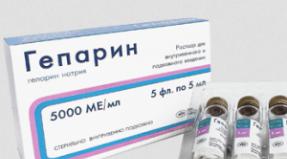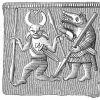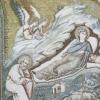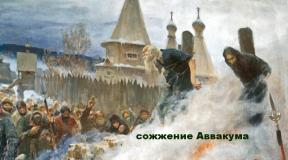Myocardial infarction with ST segment elevation, with Q wave (transmural). Myocardial infarction with ST-segment elevation, with Q wave (transmural) Past myocardial infarction, μB code 10
in accordance with ICD-10 distinguishes the following
121 - Acute myocardial infarction, specified as acute or established
lasting 4 weeks (28 days) or less after the onset of an acute onset:
121.0 - Acute transmural infarction of the anterior myocardial wall.
121.1 - Acute transmural infarction of the lower myocardial wall.
121.2- Acute transmural myocardial infarction of other specified localizations.
121.3 - Acute transmural myocardial infarction of unspecified localization.
121.4 - Acute subendocardial myocardial infarction.
121.9 - Acute myocardial infarction, unspecified.
122 - Recurrent myocardial infarction (including recurrent myocardial infarction):
122.0 - Recurrent infarction of the anterior myocardial wall.
122.1 - Recurrent infarction of the lower myocardial wall.
122.8 - Recurrent myocardial infarction of another specified localization.
122.9 - Recurrent myocardial infarction of unspecified localization.
Section 123 includes complications of myocardial infarction.
Since the specified nomenclature does not fully meet the clinical requirements, then
the classification of myocardial infarction, based on the international
classification of ischemic heart disease. It is based on the consideration of several characteristics. First of all, it is size and depth.
necrosis. In accordance with these, all heart attacks are divided into Q heart attacks (large focal) and heart attacks
myocardium without Q wave (small focal). In addition, transmural infarction is separately distinguished,
subendo - and subepicardial infarctions. The presence of these options is determined by the depth and localization.
zones of necrosis.
In its development, myocardial infarction passes through a number of periods. This is the most acute stage, acute
period, subacute period and stage of scarring.
The most acute stage includes the period from the onset of pain to the appearance of the first signs of necrosis
myocardium. It ranges from 30 minutes to 2 hours. The acute period lasts from 2 to 14 days and is
the time during which the final development of necrosis and myomalacia occurs. In subacute
period, which lasts 4-8 weeks, the zone of necrosis is delimited by inflammatory
leukocyte shaft and the processes of resorption and replacement of necrotic tissues begin.
Finally, the scarring stage can continue for the remaining time required for formation
connective tissue scar. The total duration of all stages can be up to 2 months.
As already noted, the total time required for the pathomorphosis of a heart attack is about 4-
8 weeks depending on the size of the necrosis and the depth of the lesion. In accordance with this, at
the occurrence of a new heart attack within 2 months from the first, it is customary to talk about a relapse. If
more than two months have passed, then this is a second heart attack.
Typical clinical picture myocardial infarction (anginal variant) occurs in 60-70%
all cases. The development of a heart attack is sometimes preceded by intense exercise stress, stressful
the situation at home or at work, symptoms may appear against the background of a sharp increase in arterial
pressure. In a number of patients, a heart attack is preceded by an episode of progression of angina pectoris. However, often
myocardial infarction develops against the background of complete well-being, sometimes at night.
The patient complains of unbearable pain in the chest or in the region of the heart,
pressing, bursting or burning character with irradiation in left hand from the shoulder and / or to the ends
fingers. Sometimes pain can be given to the neck, under the left shoulder blade, in the lower jaw and the left half
faces. The patient is agitated, restless, unable to find a place for himself. Nitroglycerin, which previously worked well,
does not bring an effect or only slightly reduces the intensity of pain.
On an objective examination, the patient is pale, covered with sticky cold sweat, forced
provisions do not bring relief. Tachycardia is noted, extrasystole may appear.
Blood pressure ranges from hypotension to moderate hypertension. Heart tones are muffled
possibly the appearance of a functional muscular systolic murmur at the apex and in t. Botkin.
Moderate shortness of breath is registered.
A similar clinic characterizes the classic anginal variant. In addition, the debut
myocardial infarction can occur in asthmatic, gastralgic (abdominal),
arrhythmic, cardio-cerebral and painless options.
More on the topic Classification of myocardial infarction:
- 5.2. Occupational diseases, classification and causes
- Topic No. 2. Parenchymal dysproteinosis: hyaline droplet, hydropic, horny. Parenchymal lipidosis. Fatty degeneration of the myocardium, liver, kidneys. Parechymal carbohydrate dystrophies (glycogenosis).
- Topic of the lesson. HEART DISEASES. Congenital and acquired heart defects, diseases of the endocardium, myocardium, pericardium. VASCULITIS
Is a complication ischemic disease heart and is characterized by the development of acute insufficiency of blood supply to the myocardium with the emergence of a focus of necrosis in the heart muscle. In addition to the typical form of the disease, there are also atypical forms. These include:
Ø Abdominal form. It proceeds according to the type of pathology gastrointestinal tract with registration of pain in the epigastric region, nausea and vomiting. Most often, the gastralgic (abdominal) form of myocardial infarction occurs with infarction of the posterior wall of the left ventricle.
Ø Asthmatic form: begins with cardiac asthma and provokes pulmonary edema. Pain may be absent. The asthmatic form occurs more often in older people with cardiosclerosis, with repeated heart attacks or with extensive heart attacks.
Ø Brain form: in the foreground are the symptoms of cerebrovascular accident, such as stroke with loss of consciousness, occurs more often in older people with sclerosis of the cerebral vessels.
Ø The dumb (painless) form is sometimes an accidental finding during medical examination. Clinical symptoms are manifested in the form of a sudden disturbance of well-being, severe weakness, the appearance of sticky sweat; then all symptoms except weakness disappear.
Ø Arrhythmic form: the main symptom is paroxysmal tachycardia, pain syndrome may be absent.
Laser therapy is aimed at increasing the effectiveness of drug therapy, reducing pain in the seizure period, improving blood hemorheology and reducing its increased coagulation capacity, preventing disseminated intravascular coagulation, eliminating macro- and microcirculatory disorders of coronary hemodynamics in the ischemic zone, eliminating hypoxic and metabolic disorders in biological tissues, cardioprotective effect by reducing the area of necrosis, normalization of autonomic regulation of the heart.
In the acute period of the disease, blood irradiation in the ILBI mode with the use of the NIK-ILBI emitter is decisive; it is especially important to perform the procedure within the next 6 hours from the onset of the disease. The duration of the session is 15-20 minutes at a power of 3 mW. On the first day, it is allowed to perform 2 procedures with an interval of at least 4 hours.
The course treatment is 3-5 procedures.
MINISTRY OF HEALTH OF THE RUSSIAN FEDERATION
On the features of the coding of some diseases of class IX of ICD-10
The International Statistical Classification of Diseases and Related Health Problems, the tenth revision (hereinafter - ICD-10) is a single normative document for the formation of a system for recording morbidity and causes of death, as well as a means to ensure the reliability and comparability of statistical data in health care.
ICD-10 structure
ICD-10 is structured according to the hierarchical principle: class, block, heading, sub-heading.
At the heart of ICD-10 diseases is the three-digit code, which is the mandatory level of coding for mortality data for submission to WHO, as well as for international comparisons.
Unlike previous revisions, the ICD-10 uses an alphanumeric code instead of a digital one, with a letter of the English alphabet as the first character and a number in the second, third and fourth characters of the code. The fourth digit follows the decimal point. Code numbers range from A00.0 to Z99.9. The fourth character is not obligatory for the presentation of data at the international level; it is used in all medical organizations.
The three-digit ICD-10 code is called a three-digit heading, the fourth character is a four-digit subheading. Replacing a digit with a letter in the ICD-10 code increased the number of three-digit headings from 999 to 2600, and four-digit subheadings from about 10,000 to 25,000, which expanded the possibilities of classification.
ICD-10 consists of three volumes:
Volume 1- consists of two parts (in the English version - one) and contains:
- a complete list of three-digit headings and four-digit subheadings, including mainly statistical (nosological) formulations of diagnoses of diseases (conditions), injuries, external causes, factors affecting health, and referrals;
- coded nomenclature of neoplasm morphology;
- special lists of major diseases (conditions) for summary statistical development of mortality and morbidity data.
Volume 2- contains basic information and rules for using ICD-10, instructions for coding causes of death and morbidity, formats for presenting statistical data and the history of ICD development.
Volume 3- is an alphabetical index of diseases, injuries and external causes, as well as a table medicines and chemicals, containing about 5.5 thousand terms.
ICD-10 is divided into 22 class... The new XXII class was introduced in 2003. Each letter of the code corresponds to a specific class, with the exception of the letter D, which is used in classes II and III, and the letter H, which is used in classes VII and VIII. Four classes - I, II, XIX and XX use more than one letter in the first character of their codes.
Class Is a grouped list of diseases that have common characteristics. Each class contains a sufficient number of headings to cover all known diseases and conditions. Some of the free codes (disease free) are intended for use in future revisions.
Classes I-XVII include diseases and pathological conditions.
Class XIX - Injuries.
Class XVIII - symptoms, signs and abnormalities identified in clinical and laboratory studies.
Class XX - external causes of morbidity and mortality.
Unlike previous revisions, ICD-10 contains 2 new classes: XXI class ("Factors affecting the state of health and referrals to health care institutions"), designed to classify data explaining the reason for the visit of a person who is not currently sick or different circumstances of obtaining medical care and XXII class ("Codes for special purposes").
Classes are subdivided into heterogeneous blocks... representing various groupings of diseases (for example, by the mode of transmission of infection, localization of neoplasms, etc.).
Blocks, in turn, consist of three-digit rubric... which are a code consisting of 3 characters - a letter and 2 numbers. Some of the three-digit headings are for one disease only. Others are for groups of diseases.
Most of the three-digit headings are further subdivided into four-digit ones. subheadings... those. have the 4th sign. Subheadings have an unequal content: these can be anatomical localizations, complications, variants of the course, forms of diseases, etc.
Four-digit subheadings are represented by numbers from 0 to 9. A heading may not contain all 9 numbers that have different meanings. Most often, the number "8" means "other specified conditions" related to this heading, which in most cases are included in volume 3 of the ICD-10, called the alphabetical index (hereinafter referred to as the Index). The subheading with the number "9" denotes "unspecified conditions", i.e. this is the name of a three-digit heading without further indication.
A number of 3-digit headings do not have 4-character subheadings. This means that on the present stage the development of medical science, these headings do not have a generally accepted subdivision. Subcategories can be added with subsequent updates and revisions.
The fourth sign is a kind of "quality mark", as it allows, in most cases, to identify diagnoses of diseases unspecified by a doctor. It helps to assess the quality of diagnostics, which is of great importance for solving economic issues in health care, improving the qualifications of specialists, assessing the availability of medical equipment and technology, etc.
The first volume uses various concepts, descriptions, conventions, which you should always pay attention to when coding.
This special terms, double coding and conventions .
TO special terms relate:
- terms included;
- excluded terms;
- descriptions in the form of a glossary.
Dual coding some conditions:
1. The coding system is a cross (┼) and an asterisk (*).
Some formulations of diagnoses have two codes. The main one is the code of the underlying disease, marked with a cross (┼), an optional additional code related to the manifestation of the disease, marked with an asterisk (*). In official statistics, only one code is used - with a cross (┼). Codes with an asterisk (*) are given as separate three-digit headings with four-digit subheadings and are never used alone.
2. Other types of double coding:
2.1. For local infections caused by other specified pathogens, may be used additional codes B95-B97 to clarify infectious agents(for example, B97.0 - Adenoviruses).
2.2. For functionally active neoplasms from class II can be used to identify activity additional codes from class IV(e.g. E05.8, E07.0; E16-E31, E34.-).
2.3. To determine the type of tumor, a additional morphological code(ICD-10, volume 1, part 2, pp. 579-599) (for example, M8003 / 3 Malignant tumor giant cell).
2.4. Organic mental disorders (F00-F09) can have additional code to identify the original disease that caused mental disorder(e.g. G30.1 Late illness Alzheimer's).
2.5. If the condition is a consequence of exposure to a toxic substance, then use additional code from class XX to identify this substance (eg Y49.4 Neuroleptics).
2.6. For injuries and poisoning, use double coding... one code from class XIX is the code of the nature of the injury, the second is the code external cause(class XX). In world statistics, the code of the external cause is considered the main one, and the code of the nature of the injury is considered additional. V Russian Federation for injuries and poisoning, both codes are used as equivalent. This technique does not contradict world statistics and allows for a detailed analysis of injuries (for example, S02.0 Fracture of the cranial vault, V03.1 Pedestrian injured in a collision with a car, road accident).
Legend:
- round brackets ();
- square brackets ;
- colon (:);
- curly braces ">";
- abbreviations ("BDU" - without additional clarifications, "NKDR" - not classified elsewhere);
- the union "and" in the names;
- dot dash ".-".
The index contains "leading terms" located in the left column, and "modifying" (clarifying) terms located at different indentation levels below them.
Definitions that do not affect the code are enclosed in parentheses. They may or may not be present in the formulation of the diagnosis.
Code numbers following terms refer to the corresponding headings and subheadings. If the code is three-digit, then the heading has no subcategory. In most cases, subheadings have a fourth character. If instead of the 4th character there is a dash, this means that the necessary subheadings can be found and clarified in the complete list (ICD-10, volume 1).
The legend in the third volume includes “conditions not elsewhere classified” (NEC) and cross-references.
Diagnosis coding algorithm
To assign a code to a particular formulation of the diagnosis, a special coding algorithm is used:
- In the medical record containing information about the disease or cause of death, it is necessary to determine the wording of the diagnosis to be encoded.
- In the formulation of the diagnosis, it is necessary to define the leading nosological term and search for it in the Index.
In the Index, the term is most often expressed in the form of a noun. It should be remembered, however, that adjective or participle names of some painful conditions appear as leading terms in the Index.
- Having found a leading nosological term in the Index, it is necessary to familiarize yourself with all the notes below it and be guided by them.
- Next, you need to familiarize yourself with all the terms indicated in parentheses after the leading term (these definitions do not affect the code number), as well as with all terms indented under the leading term (these definitions can affect the code number), before until all the words in the nosological formulation of the diagnosis are taken into account.
- Any cross-references ("see" and "see also") found in the Index should be followed carefully.
- To make sure that the code number selected in the Index is correct, compare it with headings 1 of volume ICD-10 and take into account that the three-digit code in the Index with a dash in place of the fourth character means that in volume 1 of ICD-10 you can find the corresponding subheading with the fourth familiar. Further subdivision of such headings by means of additional code characters is not provided in the Index, and if used, it should be indicated in Volume 1 of ICD-10.
- When using the 1st volume of ICD-10, it is necessary to be guided by all included or excluded terms under the selected code or under the name of a class, block or heading.
- Then the formulation of the diagnosis must be assigned a code.
- It is important not to forget about the double coding of some states, or the system of symbols with signs (┼) and (*).
Ciphers marked with (*) are not used in official statistics and are used only for special purposes.
In hospital statistics, only the underlying disease is coded (complications of the underlying disease, background, competing and concomitant diseases are not coded). In outpatient statistics, in addition to the underlying disease, all other existing diseases are coded, except for the complications of the underlying disease. In the case of death, all recorded conditions are coded, but only the original cause of death is included in the mortality statistics, which sometimes does not match the wording of the final clinical or pathological (forensic) diagnosis. All other condition codes are used for multiple cause of death analysis.
Principles of coding diagnoses used in statistics of morbidity by referral
Practicing physician at registration medical records for each case or episode of medical care, first of all, select the "main" disease (condition) for registration, as well as record the associated diseases.
Correctly completed medical documentation is necessary for the quality organization of patient care and is one of the valuable sources of epidemiological and other statistical information on morbidity and other problems associated with the provision of medical care.
Each "nosological" diagnostic formulation should be as informative as possible in order to classify the condition under the appropriate ICD-10 heading.
If by the end of the episode of medical care an accurate diagnosis has not been established, then the information should be recorded that best allows you to form the most correct and accurate idea of the condition for which the patient was treated or examined.
The "main" condition and "other" (concomitant) conditions related to this episode of medical care should be indicated by the attending physician, and coding in such cases is not difficult, since the designated "main" condition should be taken for coding and processing of data.
If a statistician or medical statistician has difficulties in checking the choice and coding of the "main" condition by the physician, that is, there is medical document with a clearly incompatible or incorrectly recorded "main" condition, it should be returned to the doctor for a more accurate diagnosis.
If this is not possible, the special rules set out in Volume 2 of ICD-10 apply.
“Other” conditions related to the episode of care should always be recorded in addition to the “underlying” condition, even in the case of a single cause incidence analysis, as this information can assist in selecting the correct ICD-10 code for the “major” condition ...
Coding principles for causes of death
Cause of death statistics are based on the concept of "original cause of death", which was endorsed at the International Conference on the Sixth Revision in Paris in 1948.
The original cause of death is:
- illness or injury that caused the chain of events that directly led to death;
- the circumstances of the accident or act of violence that caused the fatal injury.
This definition is dictated by the fact that by building a chain of events that led to death, in some cases it is possible to influence it in order to prevent death.
In case of death, a medical certificate of death (hereinafter - the Certificate) is issued by a doctor or paramedic. Filling in the Certificate is carried out according to certain rules.
Clause 19 of the section "Causes of death" of the Certificate must be completed on the basis of medical documentation - "postmortem epicrisis", in the final part of which the final diagnosis must be clearly reflected: the main clinical or pathological diagnosis with complications, background, competing and concomitant diseases.
The causes of death are recorded in strict accordance with the established requirements (letter from the Ministry of Health and Social Development of Russia dated January 19, 2009 N 14-6 / 10 / 2-178):
in each subparagraph of part I, only one cause of death is indicated, while the line of subparagraph a), the lines of subparagraphs a) and b), or the lines of subparagraphs a), b) and c) can be filled in. The line of subparagraph d) is filled in only if the cause of death is injury and poisoning;
filling in part I of clause 19 of the Certificate is carried out in the reverse order to the main disease with complications: the wording of the main disease is entered, as a rule, on the line of subparagraph c). Then 1-2 complications are selected, of which they make up a "logical sequence" and write them down on the lines of subparagraphs a) and b). In this case, the state written in the line below must be the cause of the state written in the line above. It is allowed to select the causes of death for the Certificate in a different order, starting with the immediate cause;
in part I of clause 19, only one nosological unit can be recorded, if this is not stipulated by the special rules of ICD-10.
Part II of paragraph 19 includes other causes of death - those other important diseases, conditions (background, competing and concomitant) that were not associated with the original cause of death, but contributed to the onset of death. In this case, only those conditions are selected that had an impact on this death (made the underlying disease worse and accelerated death). This part also indicates the fact of the use of alcohol, drugs, psychotropic and other toxic substances, their content in the blood, as well as performed operations or other medical interventions (name, date), which, in the doctor's opinion, were related to death. The number of recorded states is not limited.
A number of diseases, such as some cerebrovascular diseases, coronary heart disease, bronchial asthma, alcohol-related diseases, etc. often contribute to death, therefore, if they were in the life of the deceased (s), they must be included in Part II of paragraph 19 Testimonials.
It is not recommended to include in the Certificate as causes of death symptoms and conditions accompanying the mechanism of death, such as heart or respiratory failure, which occur in all the deceased.
Statistical studies should be carried out not only for the initial, but also for multiple causes of death. Therefore, the Medical Certificate encode all recorded diseases (conditions), including Section II. Whenever possible, the entire logical sequence of interrelated reasons is indicated.
The ICD-10 initial cause of death code is recorded in the "ICD-10 Code" column opposite the selected initial cause of death and underlined. Codes of other causes of death are recorded in the same column, opposite each line, without underlining.
In the column "Approximate time period between the onset of the pathological process and death", opposite each selected cause, the time period is indicated in minutes, hours, days, weeks, months, years. It should be borne in mind that the period indicated on the line above cannot be more than the period indicated on the line below. This information is necessary to obtain information about the average age of deaths in various diseases (conditions).
After completing all the required lines of clause 19 of the Medical Certificate of Death, you must assign a code to all recorded conditions and find the original cause of death.
If the Certificate is completed in accordance with the established requirements and the logical sequence is observed, then in accordance with the "General Principle" the original cause of death will always be on the lowest completed line of Section I.
If the requirements are not met when completing the Certificate, then the selection and modification rules set out in Volume 2 of ICD-10 should be applied.
Features of filling out medical documentation and coding diagnoses
The transition of all healthcare institutions of the Russian Federation since 1999 to the International Statistical Classification of Diseases and Related Health Problems, revision 10 marked the adoption of a new international terminology used in many countries of the world.
In this regard, in the practice of a doctor, sometimes difficulties arise in filling out medical documentation, correct diagnosis and coding. various diseases and states.
The main types of medical records of the polyclinic and hospital include:
"Medical card of an outpatient patient" (form N 025 / u-04);
"Outpatient coupon" (form N 025-12 / y-04);
"Medical card of an inpatient" (form N 003 / y);
"Statistical card of those who left the hospital" (form N 066 / y-02);
"Medical certificate of death" (form N 106 / u-08).
The main types of reporting medical documentation:
federal statistical observation form N 12 "Information on the number of diseases registered in patients living in the service area of the medical institution";
federal statistical observation form N 14 "Information on the activities of the hospital".
In the medical records, the diagnosis should be recorded in full, without abbreviations, corrections, in neat handwriting.
When formulating a clinical diagnosis, it should be categorize... that is, split into sections. The following sections are considered generally accepted:
1. The underlying disease.
2. Complications of the underlying disease, which must be grouped by severity.
3. Background and concurrent diseases.
4. Concomitant diseases.
The main disease is considered to be that disease (injury, poisoning), which in itself or through its complications was the reason for seeking medical help, became the cause of hospitalization and (or) death. In the presence of more than one disease, the "main" disease is considered to be the one that accounted for the largest share of the medical resources used.
The International Statistical Classification of Diseases is not a model for formulating a clinical diagnosis, but only serves to formalize it.
It is unacceptable to use the names of classes, blocks and groups of diseases as a diagnosis ("ischemic heart disease", "cerebrovascular disease", "general atherosclerosis", etc.). Only one specific nosological unit. Clinical diagnosis cannot be substituted by listing the syndromes or symptoms of the disease.
The diagnosis must be sufficient and formulated so that it can be translated into the international statistical code, which is used later for the extraction of statistical data.
The coding of diseases is the responsibility of the attending physician. A statistician or medical statistician is responsible for quality control of the coding, he must check the correctness of the coding of diagnoses by the doctor, and in case of discrepancy - correct the code; if it is impossible to pick up the ICD-10 code for the recorded state, the accounting statistical document should be returned to the attending physician for corrections.
Filling out accounting and reporting documents, as well as coding some diseases from class IX "Diseases of the circulatory system" can cause difficulties for doctors in their practice and have their own characteristics.
A. Outpatient polyclinic organizations and departments
1. "Outpatient coupon"- the main accounting document of the polyclinic, in which, for statistical accounting, the diagnosis must be correctly formulated and recorded and all conditions, except for the main complications, must be coded.
If the patient has applied for medical help, bypassing the clinic, to the hospital, then the "Outpatient coupon" (hereinafter - the coupon) is filled out in the polyclinic after the patient is discharged from the hospital on the basis of the "Discharge Epicrisis". In this case, if the patient comes to the appointment, then a note is made in the Ticket about the registration of all diseases in order to include this information in the federal statistical observation form No. 12 and a note about the visit is made. If the patient does not come to the appointment, then all diseases are registered in the Ticket without a mark about the visit.
An appeal for a disease must also be registered in the Ticket, which includes one or more visits, as a result of which the purpose of the appeal is achieved.
A visit is a contact of a patient with a doctor of an outpatient clinic (unit) or a hospital (without subsequent hospitalization) for any reason, followed by an entry in the "Medical record of an outpatient", including complaints, anamnesis, objective data, diagnoses with their coding according to ICD- 10, health group, examination and follow-up data, prescribed treatment, recommendations.
When filling out the Ticket, the doctor also makes notes on the date of the first detected primary and concomitant diseases, taking and removing from the dispensary register. These data are required to fill out the federal statistical observation form N 12.
1.1. Block "Acute rheumatic fever" (I00-I02).
"Acute rheumatic fever" is an acute illness lasting up to 3 months. Outcomes: recovery and transition to another disease - chronic rheumatic heart disease.
1.2. Block "Ischemic heart disease" (I20-I25).
- these are acute forms of ischemic heart disease. If myocardial infarction is diagnosed for the first time in a patient's life, it is coded as "acute myocardial infarction" (I21), all subsequent myocardial infarctions in the same patient are coded as "repeated myocardial infarction", code I22.-, first identified.
The duration of myocardial infarction is determined by ICD-10 and is 4 weeks or 28 days from the onset of the disease.
Myocardial infarction (acute or recurrent), defined as an underlying condition diagnosed at the end of an episode of medical care (outpatient or inpatient), is always recorded as an acute newly diagnosed disease (with a + sign).
Recurrent posterior wall myocardial infarction I22.8
Complications: cardiogenic shock
atrial fibrillation
pulmonary edema
Concomitant diseases: postinfarction cardiosclerosis
hypertensive disease with predominant heart damage and heart failure.
If the patient was treated on an outpatient basis or was admitted to a hospital with a diagnosis of acute or repeated myocardial infarction, then within this episode of medical care, regardless of the duration of hospitalization, an acute or repeated myocardial infarction is recorded.
In the case of a lethal outcome, regardless of the duration of hospitalization, acute or repeated myocardial infarction is also recorded.
Removal of the patient from the register is carried out after discharge from the hospital in connection with registration for another disease (postinfarction cardiosclerosis) or in connection with death.
1.3. Block "Cerebrovascular diseases" (I60-I69).
I60 Subarachnoid hemorrhage
I61 Intracerebral hemorrhage
I62 Other nontraumatic intracranial hemorrhage
I63 Brain infarction
I64 Stroke not specified as hemorrhage or infarction
I65-I66 Blockage and stenosis of the precerebral and cerebral arteries, not leading to cerebral infarction (in cases of death, the codes of these diagnoses are replaced by the code I63.-).
There are acute forms of cerebrovascular diseases lasting up to 30 days (order of the Ministry of Health and Social Development of Russia dated 01.08.2007 N 513) - headings I60-I66, chronic forms are classified in heading I67. The consequences of cerebrovascular diseases (heading I69) are used only for the registration of deaths.
Recurrent acute forms of cerebrovascular diseases, defined as the main conditions diagnosed during an episode of medical care (outpatient or inpatient, regardless of the duration of hospitalization), are always recorded as acute newly diagnosed diseases (with a + sign).
The consequences of cerebrovascular diseases exist for a year or more since the onset of the acute form of the disease, include various states classified in other headings (ICD-10, vol. 1, part 1, p. 512).
In the statistics of morbidity, the heading of consequences (I69) should not be used, but it is necessary to indicate specific conditions that were the result of acute forms of cerebrovascular diseases, for example, encephalopathy, paralysis, etc. (ICD-10, vol. 2, pp. 115-116). At the same time, the minimum period of time is not set.
According to the ICD-10 rules, headings I65-I66 should not be used to register deaths. In the statistics of lethality (mortality), the codes of acute forms (headings I60-I64) and the consequences of cerebrovascular diseases (heading I69) are used as the initial cause.
The approximate wording of the final clinical diagnosis:
Cerebral infarction caused by thrombosis of cerebral arteries I63.3
Complications: cerebral edema
right-sided hemiparesis
total aphasia
Concomitant diseases: atherosclerotic cardiosclerosis
arterial hypertension.
If the patient was treated on an outpatient basis or was admitted to a hospital with a diagnosis of one of the acute forms of cerebrovascular diseases, then, within a given episode of medical care, regardless of its duration, an acute form of cerebrovascular disease is recorded; if the diagnosis was made later than 30 days from the onset of the disease, then registration is made according to the final clinical diagnosis- one of the chronic forms classified in heading I67, or conditions in the headings of specific neurological disorders, but not according to the consequences of cerebrovascular diseases (heading I69).
Deregistration is carried out after the end of an episode of medical care and in connection with registration for another nosological unit (chronic form classified in heading I67, or conditions in the headings of specific neurological disorders) or in connection with death.
2. Federal statistical observation form N 12- for this form, the registration of diseases is carried out according to the territorial principle when providing medical care in the polyclinic according to the data of Talon (information for filling out the Ticket after hospitalization is contained in the "Discharge Epicrisis").
2.1. Block "Acute rheumatic fever" (I00-I02).
2.1.1. Up to 3 months from the onset of the disease "Acute rheumatic fever" is recorded according to the corresponding row of tables 1000, 2000, 3000 and 4000 as a newly diagnosed disease (c +).
2.1.2. Since "Acute rheumatic fever" chronic form does not have, then it is not subject to re-registration (the data lines in the columns "Total registered" and "including with the diagnosis established for the first time in life" of tables 1000, 2000, 3000 and 4000 should be equal).
2.1.3. Dispensary registration "Acute rheumatic fever" is subject to within 3 months (the data in the column "Consists of dispensary supervision"tables 1000, 2000, 3000 and 4000 should be equal to about 25% of the number of newly identified).
2.1.4. In case of recovery, if further observation is necessary from the point of view of the doctor, then the codes of class XXI "Factors affecting the state of health of the population and referrals to health care institutions" should be used (Z54 State of recovery; Z86.7 Personal history of circulatory system diseases; Z91 B personal history of risk factors). Information is reflected in tables 1100, 2100, 3100 and 4100.
2.1.5. If the outcome of "Acute rheumatic fever" is chronic rheumatic heart disease, then the registration of chronic rheumatic heart disease is made according to the line of the same name, as a newly diagnosed disease (another nosological unit), and subsequently re-registered in the prescribed manner (once a year with -) in during the entire period of dispensary observation. In this case, according to the line "Acute rheumatic fever", the patient is removed from the register.
2.1.6. In the event of the patient's death from "acute rheumatic fever" (if the patient was observed in the clinic or there is appropriate medical documentation), a "Medical death certificate" is issued (registration form N 106 / y-08. Approved by order of the Ministry of Health and Social Development of Russia dated December 26, 2008 N 782n ).
2.2. Block "Ischemic heart disease" (I20-I25).
Headings "Acute and repeated myocardial infarction" (I21-I22)- in accordance with ICD-10, registration of myocardial infarction (acute or repeated) is carried out up to 28 days from the day of the disease.
2.2.1. Within an episode of medical care, if the diagnosis is made up to 28 days from the onset of the disease, then acute or repeated myocardial infarction is recorded, regardless of the duration of hospitalization.
2.2.2. If the episode of medical care began later than 28 days after the onset of the disease, then postinfarction cardiosclerosis is recorded (I25.8). If within 28 days the first hospitalization ended and the second began, then at the second hospitalization postinfarction cardiosclerosis is recorded (code I25.8).
2.2.3. Because acute diseases are not subject to re-registration, then the data of the corresponding lines in the columns "Total registered" and "including with the diagnosis established for the first time in life" of tables 3000 and 4000 of reporting form N 12 must be equal.
2.2.4. Acute and repeated myocardial infarctions are subject to dispensary observation for 28 days, and therefore in the column "Is under dispensary supervision" of tables 3000 and 4000, only those myocardial infarctions that were registered during this period for form No. 12, i.e. e. in the month of December of the reporting year.
2.2.5. In case of death from acute or repeated myocardial infarction, it should be remembered that not all cases of myocardial infarction are coded I21-I22:
- with a combination of acute or repeated myocardial infarction with a malignant neoplasm, diabetes mellitus or bronchial asthma These diseases are considered the initial cause of death, and myocardial infarctions are their complications (ICD-10, vol. 2, p. 75), these combinations must be correctly reflected in the final postmortem diagnosis, the period of time remains - no later than 28 days from the onset of the onset of a heart attack or within an episode of care;
- in other cases, the initial cause of death should be considered acute or repeated myocardial infarction (codes I21-I22) within a period of up to 28 days or within an episode of medical care (even if the episode ended later than 28 days);
- if the diagnosis of myocardial infarction was established after 28 days from its onset, the initial cause of death should be considered postinfarction cardiosclerosis, code I25.8 (ICD-10, vol. 1, part 1, p. 492);
- code I25.2 is not used as the initial cause of death, this condition means myocardial infarction, suffered in the past and diagnosed by ECG, in the current period - asymptomatic. If there is a record in the primary medical documentation about a previous myocardial infarction as a single condition and the absence of diagnoses of other diseases, the initial cause of death should be considered postinfarction cardiosclerosis, code I25.8;
- codes I23 and I24.0 do not apply as the initial cause of death, it is necessary to use codes I21-I22 (ICD-10, vol. 2, p. 61);
- when myocardial infarction (acute or repeated) is combined with diseases characterized by high blood pressure, priority in choosing the initial cause of death is always given to myocardial infarction (ICD-10, vol. 2, pp. 59-61).
2.2.6. In the event of the patient's death from "acute or repeated myocardial infarction" (due to the initial or immediate cause of death), a "Medical Death Certificate" is issued (registration form N 106 / y-08, approved by order of the Ministry of Health and Social Development of Russia dated December 26, 2008 N 782n).
ICD-10 code - acute myocardial infarction
Ischemic heart disease (CHD) is a pathological condition that occurs due to a violation of the supply of oxygen to the myocardium (heart muscle). IHD can manifest itself in the form of an acute form (myocardial infarction) or have a periodic course (the occurrence of angina attacks). The sooner the correct diagnosis is made, the less the risk of unpleasant complications. The cardinal difference between the necrotic process in the heart muscle and the manifestation of angina pectoris caused by short-term compression of the coronary vessels is the ineffectiveness of nitroglycerin.
Separation of ischemic heart disease according to ICD-10
Such a broad term as ischemic heart disease refers to the IX class called "Diseases of the circulatory system." This section includes a very serious illness, for example, cerebral infarction, the ICD-10 code of which is I-63, various cerebrovascular and systemic vascular ailments. Per international classification diseases of the 10th revision, necrosis of myocardial sections can occur in different ways, therefore, myocardial ischemia is divided into several subspecies depending on the cause of the pathological process and the number of seizures in the anamnesis.
 Acute myocardial infarction - necrosis of an area of the heart muscle caused by a circulatory disorder
Acute myocardial infarction - necrosis of an area of the heart muscle caused by a circulatory disorder IHD for ICD-10 includes diagnoses under the numbers:
- I-20 - typical angina pectoris;
- I-21 - acute myocardial infarction (AMI);
- I-22 - repeated necrosis of the heart muscle;
- I-23 - complications of AMI;
- I-24 - other forms of acute coronary heart disease;
- I-25 - chronic coronary artery disease.
A transition of less dangerous angina pectoris to a very serious myocardial damage is possible if appropriate treatment is not undertaken in time. For localization, a large-focal and small-focal form of the disease is distinguished. The acute form of myocardial infarction has a specific code, the ICD-10 assigned the value I-21 to this disease. In the presence of a small area of necrosis, there is no pathological Q wave, which complicates the diagnosis, the risk of tissue necrosis being transformed into a macrofocal form is increased.
What subspecies is acute myocardial infarction divided into?
 A sudden cessation of blood supply to a separate tissue site of the organ and the resulting consequences are called a heart attack.
A sudden cessation of blood supply to a separate tissue site of the organ and the resulting consequences are called a heart attack. The necrotic process is capable of developing in various parts of the heart, it arises as a result of many adverse factors and is differentiated by complexity.
If there is significant necrosis of myocardial tissue, only narcotic analgesics are suitable for relieving pronounced pain. Mainly the right or left ventricle may be affected, the heart wall as a whole or a small layer of it succumbs to necrosis. With each repeated attack, the pathological process intensifies, more and more cells are affected, which is fraught with significant disturbances in the work of the heart.
Depending on the localization of the site of necrosis, it was decided to distinguish several subspecies of the disease:
- Acute transmural infarction of the anterior (I0) and lower (I21.1) walls of the heart muscle.
- Acute transmural infarction of other parts of the heart muscle with a certain (I2) and unknown (I21.3) localization.
- Acute subendocardial necrosis of the heart muscle (I4).
- MI, unspecified (I9).
Sometimes it is extremely difficult to establish a clear location of a site of necrotic tissue, since the disease can pass almost imperceptibly. Most often, acute myocardial infarction occurs, the ICD-10 code of which is I-21, it affects mainly the posterior wall of the myocardium.
 Typical cases of myocardial infarction are characterized by extremely intense pain syndrome with pain localized in chest and irradiation to the left shoulder, neck, teeth, ear, collarbone
Typical cases of myocardial infarction are characterized by extremely intense pain syndrome with pain localized in chest and irradiation to the left shoulder, neck, teeth, ear, collarbone The diagnosis is complicated by a large variety of forms of the disease. There is irradiation of pain in the back, left scapula, epigastric region, signs of shortness of breath appear, moreover, often heart damage is accompanied by a deterioration in cerebral circulation.
Dangerous complications of cardiac muscle necrosis
The international classification distinguishes the transferred myocardial infarction, which has the ICD code I-25.2. It can be detected after careful examination of the ECG results, since the site of necrosis is replaced by connective tissue. It is not in vain that doctors distinguish a postponed myocardial infarction as a separate ailment, the absence of symptoms cannot be called complete recovery if there is an acute form of coronary heart disease in the anamnesis.
Even a single attack can provoke irreversible changes in the heart, which, if untreated, cause:
- cardiogenic shock;
- change in the conducted system of the heart;
- thrombus formation;
- aneurysm of the heart.
- acute cardiovascular failure;
Treatment methods different types coronary artery disease will vary. Cerebral infarction, the ICD-10 code of which is I-63, and necrosis of the heart muscle occur due to specific reasons, therefore, therapy should be selected depending on the affected organ. You should pay attention to the variety clinical manifestations ailment. In some people, an attack of acute ischemia of the heart muscle is accompanied by a hypertensive crisis, while others lose consciousness for a while due to a collapse due to a sharp fall blood pressure.
Extensive infarction is the most severe form of heart pathology associated with acute insufficiency of blood supply to the myocardium. With this dangerous violation, a vast zone of the heart muscle is completely deprived of the supply of nutrients and oxygen. Due to a long-term lack of blood supply to the myocardium, an extensive heart attack occurs. Thousands of lives every minute are carried away in the world by a necrotic lesion, a transmural infarction. Correct timely treatment helps to save the sick.
Etiology
Just one reason is enough for the development of an acute heart attack. A complex of several causes and provoking factors in all cases causes extensive myocardial infarction. Men are prone to this pathology more often.
As a rule, the causes of transmural infarction are:
- spasms of the coronary arteries;
- atherosclerosis;
- previously suffered a heart attack;
- thrombosis, fatty embolism;
- arrhythmia;
- surgical intervention;
- an increase in androgen levels, as indicated by male pattern baldness;
- hypertonic disease;
- diabetes;
- genetic predisposition;
- angina pectoris.
Provoking factors:
- alcoholism;
- snoring during sleep;
- chronic overwork;
- physical or emotional stress;
- age in women over 50;
- alcohol abuse and smoking, which provokes narrowing of the coronary arteries;
- sedentary lifestyle;
- violation of microcirculation;
- overweight;
- being in constant stress;
- psychological trauma;
- kidney pathology;
- belonging to the male sex;
- not proper nutrition.
Development mechanism
Throughout a person's life, the heart receives proper nutrition in the form of oxygen and works continuously. Often, the disease develops gradually. Myocardial tissue begins to die when blood circulation is impaired. The lumen of the coronary arteries is narrowed due to the deposition of cholesterol plaques on their walls. Since oxygen is not supplied to the heart, metabolic products accumulate.
Coronary circulation after a massive heart attack is suddenly impaired. Extensive necrotic myocardial damage penetrates the entire thickness of its tissues. The heart muscle pumps blood with difficulty, symptoms of a formidable ailment appear.

Manifestations
Intense pain is felt behind the breastbone. It is burning, squeezing or crushing in nature. Such pains radiate to the left shoulder blade or arm. Characterized by the strongest fear due to the fear of death. A patient with symptoms of a massive heart attack does not have enough air, intense shortness of breath occurs. The problem is often complemented by cyanosis and pallor of the skin, increased heartbeat.
Stages of development
There are 5 periods of development of an extensive heart attack:
- The pre-infarction state lasts from several hours to 30 days. It is characterized by an increase in the number of angina attacks.
- No more than 2 hours - the duration of the most acute period. The classic clinical picture of a cardiovascular accident occurs at this time. The heart rate decreases or increases, blood pressure drops. Burning pains occur.
- The acute period lasts 2-10 days. An area of necrosis is formed in the myocardium.
- The subacute period lasts 4-5 weeks. The pain syndrome disappears. At the site of development of necrosis, a rough scar is formed.
- The postinfarction period takes 3-6 months. The body adapts to new conditions of life.
First aid and treatment
Disastrous consequences arise if signs of a massive heart attack appear, but the patient does not receive emergency medical attention. Severe complications or death are often the result of this condition. It is important to be able not to get confused in order to save the patient's life, to reduce the consequences of the disease.
Dense thrombus in coronary artery cannot be removed with medication if more than 6 hours have passed since the cardiovascular accident. While waiting for the arrival of doctors, the patient needs to be packed and given 1 tablet of nitroglycerin, the same amount of aspirin. The doctor who arrives on call makes an electrocardiogram to assess the severity of the patient's condition. He administers special medications to the patient.
Basic principles of treatment:
- long period of rehabilitation;
- limitation of the zone of necrosis;
- restoration of arterial blood flow;
- effective pain relief is the primary concern;
- prevention of re-infarction.
From the first days of the disease, the patient is prescribed drug treatment:
- beta blockers, which improve survival;
- under the control of the lipid spectrum, statins are needed to lower cholesterol;
- ACE inhibitors - powerful vasodilators, they reduce high blood pressure;
- nitrates to eliminate vasospasm;
- diuretics remove excess fluid, reduce the load on the heart;
- acetylsalicylic acid prevents blood clots.
A patient who has suffered a massive myocardial infarction after an attack requires strict bed rest for the first 2 days. Surgical treatment may be offered if indicated.
During the rehabilitation period, the patient is shown:
- a complex of vitamin preparations;
- necessary medicines;
- psychological support;
- physiotherapy;
- adequate diet;
- lifestyle correction.
How long do you live after an attack of a massive heart attack? It depends on the implementation of all the recommendations of the attending physician. To avoid coronary death of a patient, a correct course of rehabilitation is required. Quit smoking, limit alcohol consumption. You should and can eat foods that lower cholesterol and blood sugar levels.
Causes and symptoms of pulmonary edema in myocardial infarction
Pulmonary edema with myocardial infarction is a pathological process that accompanies heart failure. At the same time, the cells of the affected area of the myocardium (heart muscle) die, since due to the failure of the blood flow of the coronary arteries, the supply of oxygen and nutrients to the heart stops. This may be accompanied by the development of pulmonary edema, which is caused by the accumulation of blood plasma secreted from the vessels in the lung tissues and alveoli. Thus, a heart attack is complicated by the patient's breathing problems, this is an extremely dangerous condition that can lead to the death of the patient and requires an immediate response.
According to ICD-10, the disease was assigned the code 121, and its complication in the form of pulmonary edema - 150.1.
Why does the disease develop?

Cardiologists associate the development of this complex of pathologies with two factors:
- Blockage of a coronary artery as a result of atherosclerosis, or significant narrowing of the lumen.
- Too much high pressure in the ventricle due to some pathologies of the heart.
As you know, the work of the heart is to pump blood. The heart contracts in cycles, while the myocardium either relaxes or contracts again. When the heart relaxes (so-called diastole), the ventricle fills with blood, and during systole (contraction) it is pumped into the blood vessels by the heart.
When a patient develops a heart attack, the ventricles lose the ability to completely relax. This is due to the death of a part of the muscle cells - necrosis.
Similar problems with the ventricles are observed in other pathologies: 
- ischemic disease;
- aortic stenosis;
- high pressure;
- hypertrophic cardiomyopathy.
But if during a heart attack the cause of ventricular dysfunction is necrosis, in these cases, other pathological changes act as such.
It consists in the fact that during a heart attack, the blood stagnates in the capillaries of the lungs and the pulmonary circulation. Gradually, hydrostatic pressure grows in them, and plasma penetrates into the lung tissue and interstitial volume, which is "squeezed" from blood vessels... This process causes acute respiratory dysfunction and can be fatal to the patient.
Symptoms
In medicine, it is customary to consider the following symptoms as indicators of a heart attack with edema:
- significant pain"Under the spoon", behind the sternum or in the region of the heart;
- progressive weakness;
- increased heart rate up to 200 beats per minute, or even more (severe tachycardia);
- increase in blood pressure;
- shortness of breath, shortness of breath;
- the presence of wheezing in the lungs. They are dry at first, gradually turn into wet;
- shortness of breath on inspiration;
- wet cough;
- cyanosis (blueness of the skin and mucous membranes);
- the patient is thrown into a cold sweat.
 As the pathological condition develops, the temperature rises, but does not exceed 38 degrees. The symptom can develop either five to six hours after a heart attack, or within a day.
As the pathological condition develops, the temperature rises, but does not exceed 38 degrees. The symptom can develop either five to six hours after a heart attack, or within a day.
When the edema completely spreads to the lungs (this is especially characteristic of heart failure with damage to the left ventricle and the heart attack itself), shortness of breath increases. Gas exchange in the lungs continues to deteriorate, and the patient experiences bouts of suffocation. The liquid gradually enters the bronchi and alveoli, the latter stick together, and wet rales are heard in the lungs of patients.
Consequences of a heart attack with edema
The death of a patient can be prevented if timely and correct assistance is provided to him. If first aid was not provided, then there is a high probability of death due to asphyxia or atrial fibrillation.
The considered type of myocardial infarction can cause the following consequences:
- cardiogenic shock. The patient's pressure drops, the pulse becomes threadlike, and the heart muscle eventually stops;
- cardiosclerosis: after a heart attack, the heart tissue that has died as a result of an attack is scarred;
- atrioventricular block: violation of the conduction of electrical impulses inside the heart, up to the complete cessation of their passage;
- fibrinous periocarditis. This pathology is characterized by inflammatory process affecting the fibro-serous cardiac membrane;
- postinfarction aneurysm, in which that part of the wall of the heart ventricle that was affected begins to bulge. This pathology can occur several months after a heart attack, and is recorded in about 15 cases out of 100;
- there is a possibility of developing pulmonary infarction. Some of the lung tissue may also die off and be replaced by scar tissue;
- cerebral infarction.
Diagnostics and patient care
 The initial diagnosis is usually made by on-site emergency medical personnel. It is quite simple for a trained specialist to determine the cause of the patient's malaise, since the clinical picture of the manifestations of a heart attack and pulmonary edema is visible very clearly and allows a fairly accurate conclusion to be drawn based on the initial examination.
The initial diagnosis is usually made by on-site emergency medical personnel. It is quite simple for a trained specialist to determine the cause of the patient's malaise, since the clinical picture of the manifestations of a heart attack and pulmonary edema is visible very clearly and allows a fairly accurate conclusion to be drawn based on the initial examination.
Diagnosis is clarified by ECG and listening heart rate... When a patient is admitted to hospital for treatment, he is also given ultrasound diagnostics of the lungs and heart (or X-ray examination of those). Additionally, they take tests: the blood is examined for specific proteins and enzymes, as well as for the content of various blood cells.
In the diagnosis, it is important to remember that a number of symptoms of a heart attack are similar to those with internal hemorrhage, pneumothorax, perforation gastric ulcer, pancreatitis and some other diseases.
Before the arrival of the "ambulance", the patient should be placed in a half-sitting position. To expand the arteries of the heart, nitroglycerin is placed under the tongue of a person, one or two tablets, with an interval of 15 minutes. It is also advisable to give the patient 150 milligrams of aspirin to chew and swallow. Then you should wait for doctors to start professional treatment.
Methods for preventing heart attack include:
- Physical exercise.
- Bringing body mass index to normal.
- Rejection of bad habits.
Regular medical examinations and timely treatment of identified diseases are of great importance.
Transmural myocardial infarction: what it is, dangers and treatment
Peculiarities
The prefix "trans" in medicine and biology means "through", "through". Transmural differs from other types of infarction in that with it, cell death occurs not only in the middle heart muscle, but also in other layers of the heart - the epicardium and endocardium.
About 1/5 of all sudden deaths are due to transmural infarction. In men, the disease is 5 times more common than in women. Of all those who underwent this form, up to 19-20% die in the first month.
Causes and risk factors
 Heart attacks occur as a result of insufficient blood supply to an organ or its area. Having lost access to oxygen and nutrients, cells begin to die, that is, necrosis occurs. Transmural myocardial infarction follows the same pattern.
Heart attacks occur as a result of insufficient blood supply to an organ or its area. Having lost access to oxygen and nutrients, cells begin to die, that is, necrosis occurs. Transmural myocardial infarction follows the same pattern.
Disturbances of blood supply arise due to the fact that the lumen of the coronary artery is blocked by an atherosclerotic plaque. As a result, the heart receives less oxygen and nutrients, but in a calm state this is not dangerous.
When a stressful situation arises or a person is engaged in intense work, the blood flow rate increases, a turbulent vortex arises around the plaque. It damages the inner surface of the vessel and causes a blood clot to form, which further complicates the blood supply to the heart.
The root cause of this type of heart attack is the presence of sclerotic plaques in the coronary arteries. Risk factors are:
- Age (transmural infarction is a disease of people over 45 years old);
- Genetic predisposition;
- Increased blood cholesterol;
- Obesity;
- Smoking tobacco;
- Hypodynamia;
- Stressful situations;
- Wrong diet;
Moreover, more than 35% of cases are associated with smoking, which makes it the most important risk factor.
Complications and consequences
Of all the types of heart attack, this type is the most dangerous, as it affects all three membranes of the heart. Depending on the area of nectrotic changes, small-focal and large-focal transmural infarction are distinguished. The latter is characterized by numerous and very dangerous complications, including:

- Thromboembolism;
- Edema of the lungs (reasons, clinic, tactics of assistance);
- Paralysis of the limbs;
- Speech disorders;
- Flickering of the ventricles, which leads to death;
- Failure of various organs and systems;
- In severe cases, heart rupture.
Small blood clots, which are formed in large quantities during a heart attack, can enter with the blood stream into the head or spinal cord, blocking the capillaries and depriving the blood supply of certain parts of these organs. This is the cause of speech impairment or paralysis.
Heart rupture occurs suddenly and is a violation of the integrity of the heart in the area affected by necrosis. The larger this area is in area, the greater the likelihood of rupture.
Flicker of the ventricles is a phenomenon in which, instead of normal contractions, the ventricles of the heart begin to tremble randomly. At the same time, they cannot push blood out, which is why the blood supply to all organs and systems stops, which remain without the supply of oxygen and nutrients.
Flicker of the ventricles can soon turn into flutter - tremors with a frequency of up to 400 Hz. In this state, the heart also cannot provide blood circulation, and therefore death soon occurs.
Symptoms
Symptoms can be different and depend on the characteristics of the course of the disease. But there is also a group of symptoms common to most of those who have had acute transmural myocardial infarction:

- Frequent, painful heartbeats (tachycardia)
- Feeling of "sinking" of the heart;
- Acute compressive pain that radiates to the left arm, left shoulder blade, left half lower jaw, teeth, left ear;
- Blanching of the skin and mucous membranes;
- Undulating, prolonged pain that may not let go from several hours to a day;
- Asthma-like choking (cardiac asthma).
Diagnostics
In order to diagnose transmural myocardial infarction, an ECG must be performed. Since electrocardiography is based on the study of electrical potentials in different parts of the heart, and with necrosis, the picture of the distribution of these potentials changes dramatically, an experienced specialist will be able, on the basis of an ECG, to find out where the lesion is located, and approximately its area, and to distinguish transmural infarction from other types of necrotic changes in heart.
The area of the affected area can be found out on the basis of a blood test. So, after a heart attack, the number of white blood cells (leukocytes) rises. Leukocytosis can last up to 14 days, and when the number of leukocytes begins to decrease, the sedimentation rate of red cells (erythrocytes) increases.
First aid
Transmural infarction is a very dangerous condition, death can occur suddenly and at any time, therefore, assistance measures must be started before the arrival of the doctor. Here is a list of such events:
- Call an ambulance;
- Lay the patient in a horizontal position;
- The patient should take nitroglycerin - 1 tablet. If the pain persists, take another one after 5 minutes. Do not take more than 3 tablets;
- You should also take an aspirin tablet;
- With shortness of breath and wheezing in the lungs of the patient, you need to transfer to a sitting position, and put a roller or pillow under his back.
For more information on helping a patient with a heart attack and loss of consciousness, see the video:
Treatment tactics
At the hospital stage, treatment is based on three areas:

- Fight against pain and psychological consequences;
- Fight against blood clots;
- Fight against heart rhythm disturbances.
To relieve the patient of the pain syndrome, they use strong narcotic drugs, including morphine and promedol, and to combat fears and anxiety, tranquilizers, for example, relanium.
Thrombolytic therapy is aimed at eliminating blood clots in the coronary vessels and restoring normal blood supply to the heart. For this, drugs such as fibrinolysin, alteptase, heparin are used. The fight against blood clots should be started already in the first hours after a heart attack.
To combat arrhythmias, agents that block beta-adrenergic receptors (atenolol) and nitrates (already mentioned nitroglycerin) are used.
Forecast
The prognosis depends on the area of the lesion of the membranes of the heart. Damage to more than 50% of the myocardium leads to death. Even with a small area of the lesion, it is possible for the spine to die as a result of thromboembolism or rupture of the heart.
Even if the acute period has been passed and no serious complications have arisen, the prognosis is considered conditionally unfavorable due to irreversible changes in muscle tissue that occur as a result of a heart attack.
Rehabilitation
Proper nutrition is very important during the rehabilitation period. Food should be non-coarse, easily digestible and taken in small portions 5-6 times a day. At first, the diet should consist of cereals, dried fruits, juices and kefir. Dried apricots, beets and other foods that promote bowel movement are also useful.
Physical rehabilitation involves gradually returning the patient to physical activity. In the early stages, it is important to prevent stagnation in the lungs, muscle atrophy and other consequences of an immobile lifestyle. Gradually, as the patient recovers, classes begin physiotherapy exercises walking.
It is advisable to carry out rehabilitation measures in sanatoriums. The rehabilitation period is individual and depends both on the area of heart damage and on complications.
Prophylaxis
Prevention measures are reduced to eliminating the risk factors that are listed above. To avoid transmural infarction, you must:

- Quit smoking;
- Follow a low-cholesterol diet;
- Reduce consumption of table salt;
- Fight obesity;
- Control the pressure (it should not exceed 140/90 mm Hg);
- Avoid severe stress;
- Avoid strenuous physical activity.
Transmural infarction differs from other types of myocardial infarction in that it affects not only the myocardium, but also two other cardiac membranes (epicardium and endocradus), consisting of connective tissue... For this reason, the likelihood of heart rupture and thromboembolism increases.
Acute myocardial infarction is the necrosis of the tissues of the heart muscle in a certain area due to impaired blood circulation.
Acute myocardial infarction - ICD-10 code I21 - is one of the leading causes of death in young and old people. Often the presented lesions lead to.
Causes
The work of the human heart is a constant contraction of the myocardium, which guarantees the normal delivery of oxygen and nutrients, so necessary for the tissues of a vital organ. Thanks to the presented work of the heart in the human body, important metabolic processes take place in the cells.
- All information on the site is for informational purposes only and DOES NOT ARE a guide to action!
- Provide an EXACT DIAGNOSIS you can only a DOCTOR!
- We kindly ask you NOT to self-medicate, but make an appointment with a specialist!
- Health to you and your loved ones!
Through the significance represented, a person's heart must work uninterruptedly. But often there are unpleasant moments in the form of oxygen starvation of the tissues of the heart muscle, which provoke the onset of pathology, characterized by irreversible changes that occur in the aorta and coronary arteries.
In the case when there is a lack of blood, but it does not acquire critical marks, the sick person begins to develop reversible ischemia. Similar phenomena are accompanied by angina pain, which are localized behind the sternum.
If a person has a complete absence of blood supply, then the accumulation of toxic metabolic products begins, which should not be the case with normal blood circulation. In order not to stop its working activity, the heart switches to anaerobic mode of work, where it begins to use its internal reserves of energy.
Energy reserves run out after about 20 minutes, as a result of which the area of the heart muscle, which is bled from blood due to impaired blood circulation, dies. Such lesions of the heart are called myocardial infarction - tissue necrosis.
Tissue necrosis can be different sizes, which depends on the level of vessel overlap, the rate of ischemia, the patient's age and other factors.
Also, the cause of tissue necrosis due to impaired blood circulation includes:
In connection with the above facts, a person should be attentive to his health and begin immediate treatment if at least one factor is identified.
Kinds
Myocardial infarction is divided into several types, among which there are:
According to the type of damage to the heart muscle, the further treatment of the patient and his recovery may differ exactly.
Diagnostics of the acute myocardial infarction
During the diagnosis, the doctor finds out from the patient all the prerequisites that could lead to such disturbances in the work of the heart.
Among other things, laboratory and instrumental studies are carried out, among which are:
| Anamnesis |
|
| Includes a blood clinic that examines an increase in white blood cell count and increased ESR, and blood biochemistry, on the basis of which indicators of increased activity of enzymes, creatine canases, myoglobin, levels of electrolytes, iron and other enzymes are recorded. | |
| Instrumental research methods | , Echocardiography and coronary angiography. The presented research methods make it possible to identify the localization of a necrotic focus, impaired contractility of the affected ventricle, narrowing or overlap of blood vessels. |
The presented examinations are carried out on the first day of the patient's visit to the doctor. Here it is important to "read" the results correctly in order to determine the nature and extent of the lesion.
Treatment
Emergency care for acute myocardial infarction is carried out in the following sequence:
- the patient must be provided with complete rest;
- a person needs to be given nitroglycerin and Corvalol under the tongue;
- try to transport the patient to the cardiac intensive care unit as soon as possible.
As a rule, the transportation of the patient should be carried out by an ambulance team, which must be called immediately after the patient complained of chest pain.
Treatment in the hospital department is as follows:
- To begin with, the patient is relieved of pain syndrome using strong narcotic analgesics and antipsychotics.
- If the cause is a blockage of a coronary vessel by a blood clot, treatment is used to dissolve it. Special thrombolytic agents are injected here. The presented method should be carried out within the first hour after the onset of the attack, since delay leads to the defeat of a larger area of the heart muscle.
- Antiarrhythmic drugs are prescribed and administered to the patient.
- Treatment should be aimed at improving metabolic processes in the heart muscle.
- Treatment is aimed at reducing the volume of circulating blood, which significantly reduces the burden on the heart.
- If necessary, surgical methods of treatment are used, where balloon angioplasty of the coronary vessels is isolated, the introduction of a stent, coronary artery bypass grafting, which allows you to bypass the damaged vessel by laying a new path of blood flow.
- The patient is prescribed anticoagulants, which help to reduce blood clotting and act as.
All treatment is carried out only under the supervision of specialists who try in every way to prevent the occurrence of complications.
Complications
Myocardial infarction leads to complications, among which are:
| This is where specialists can diagnose atrial fibrillation which can lead to sudden death the patient. | |
| It is characterized by impaired activity of the left ventricle, which are associated with pumping blood. The presented type of insufficiency can lead to death due to a sharp drop in blood pressure. | |
| Pulmonary embolism | It provokes the development of pneumonia or pulmonary infarction, often ending in the death of the patient. |
| Heart tamponade | It leads to the death of a person due to the rupture of the heart muscle at the site of the lesion and the breakthrough of blood into the pericardial cavity. |
| in an acute form of manifestation | Explains the dangerous swelling of the affected area of scar tissue that occurs with extensive heart attack. The aneurysm further leads to heart failure. |
| Thromboendocarditis | A complication that is diagnosed by the deposition of fibrin on the inner surface of the heart. Torn off fibrin leads to stroke or mesenteric thrombosis, which further leads to necrosis of the intestine or damage to the kidneys. |
| Postinfarction syndrome | It is a generalized diagnosis of long-term complications. |
It is due to possible complications the patient should be in the hospital until the elimination of the acute period of myocardial infarction.

Rehabilitation stages
Rehabilitation of the patient takes place in three stages, where they are present:
The time for treatment and recovery depends on the nature and extent of the lesion. So, patients are divided into I-III classes - patients with uncomplicated myocardial infarction and IV class - patients with complications, which, in turn, are divided into three groups - mild disorders, moderate and heavy.
At the stationary stage, in addition to the administration of drugs, the patient undergoes a course of exercise therapy, which are based on the achievement of tasks such as improving mental state patient, respiration, cellular nutrition and blood circulation of the heart, prevention of work disorders internal organs, elimination of muscle tension and the subsequent and gradual increase in stress tolerance.
Physical activity is compiled on the basis of the patient's functional class, where 4 stages are distinguished, which include:
| First stage | It implies the patient's ability to turn on his side, independently use the curbstone and the boat, eat in a sitting position and sit on the bed with his legs down for several minutes. |
| Second stage | Includes the patient's ability to sit down on the bed for 20 minutes and sit on a chair on their own. |
| Third step | It is characterized by the ability to independently walk around the ward with food intake and sitting on the bed for a long time or without any restrictions. There are also staircase exits with independent walking up one flight of stairs. |
| Fourth step | It is noted that the patient can walk along the corridor without restrictions, climb one floor and complete self-service. |
During post-stationary rehabilitation, the patient faces slightly different tasks, which include:
- it is important to try to restore the previous functions of the heart;
- preventive actions of coronary heart disease are used;
- are used different methods to increase stress tolerance;
- methods for social and household adaptation are applied;
- rehabilitation actions are aimed at improving the quality of life;
- an accurate reduction in the doses of medications used is practiced.
When recovering a patient in sanatoriums and special rehabilitation centers regular group sessions are used, where a set of exercises is included to restore and strengthen all muscles, exercises for attention and coordination of movements are used.
Exercises, as far as possible, the patient is carried out while sitting or standing, in the future, weights weighing up to 5 kg are used.
Danger of relapse
Myocardial infarction is dangerous for its own, which occurs during the first three days to two months after the occurrence of damage to the heart muscle. The cause of relapse is a repeated violation of the blood flow of the affected area.
To prevent this from happening, the patient must adhere to the following rules:
| Limit physical activity | Compliance with the doctor's recommendations must be carried out unconditionally. That is why, at first, the patient is under the supervision of a specialist in the hospital, where he is provided with complete rest. |
| Stick to proper nutrition | You should refuse to eat fatty foods, and give preference to more plant foods. It is important to cut back on foods that are high in cholesterol, as this will lead to blood clot formation and re-injury. | We will talk about the chances of survival and the consequences of a massive myocardial infarction in.



















